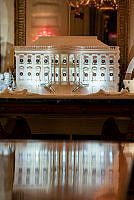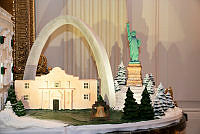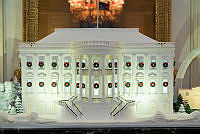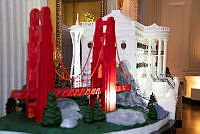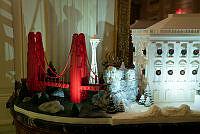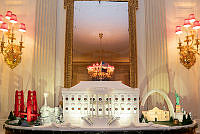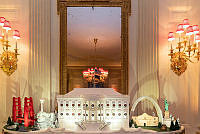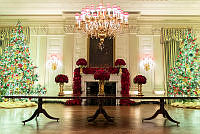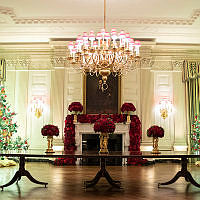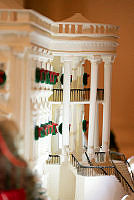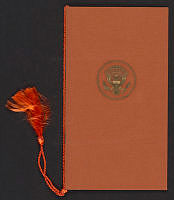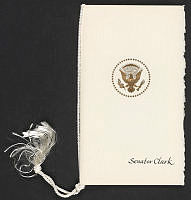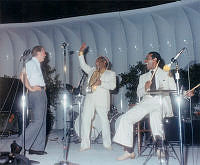Rubenstein Center Scholarship
From the Suffragists to the ERA: Women's Rights Protests and Lafayette Park
Since the Seneca Falls Convention in 1848, the public struggle for women’s rights and gender equality has unfolded for more than 170 years in the United States. One of the most pivotal moments occurred on January 10, 1917 when twelve women emerged from Cameron House, situated on the eastern side of Lafayette Square, and walked a short distance to protest the lack of voting rights for women in front of the White House. The architect of the first protest staged at the White House was Alice Paul, who had learned about the importance of such measures from her involvement in the British suffrage movement. Paul was quiet in her personal demeanor, but a brilliant political strategist. In an oral history interview about the history of the women’s suffrage movement, Paul explained the decision:
We had quite a long discussion—I guess many days and weeks, maybe – before we decided to start any pickets. When you start, you have to be prepared to come through for a long time or it is ineffective…Women volunteered to go right away.1
In hindsight, Paul did not believe the decision to picket affected nationwide opinion on suffrage. That crucial pivot came later. According to Paul, the so-called “turning point” of the movement happened “when people were willing to continue with that picketing when they knew they would be arrested.”2 In total, hundreds of women were arrested for picketing in front of the White House, and at least 168 served prison or jail sentences due to the charges levied against them.3

On October 20, 1917, Alice Paul along with Dora Lewis leave Cameron House to picket the White House.
Library of CongressAlthough the fight for women’s suffrage served as the inception for the long history of protest outside the White House, demonstrations in favor of women’s rights continued throughout the twentieth century. Women organized for several issues and causes throughout the 1960s and 1970s, including civil rights and United States military involvement in the Vietnam War. However, women began to notice they were not included in many of the leadership decisions of those social movements, and that those movements did not always reflect the priorities of women.4 The “second wave” of the women’s movement mobilized and Lafayette Park once again became a focal point for the fight for women’s rights and equal status.
On August 26, 1970, women demonstrated across the United States to commemorate the fiftieth anniversary of the ratification of the Nineteenth Amendment to the United States Constitution. In Washington, D.C., a women’s liberation march termed “Women’s Strike for Equality” began in Farragut Square and ended in Lafayette Park. Although the largest protest in the United States took place in New York City on that day, thousands of women marched in Washington, D.C. It was the first large-scale demonstration specifically for women’s rights in the nation’s capital since the suffrage pickets. About 500 women attended a rally in Lafayette Park sponsored by the organization of Federally Employed Women. At the rally, participants advocated for congressional passage of the Equal Rights Amendment (ERA), an end to gender discrimination, and equality before the law. More than twenty women’s rights leaders spoke at Lafayette Park as part of the protest.5 President Richard Nixon was in California at the time, but signed a proclamation commemorating the fiftieth anniversary of women’s suffrage and issued a public statement in support of women’s rights, signaling his support for the ERA.6

Women’s liberation march from Farragut Square to Lafayette Park on August 26, 1970.
Library of CongressAs debate over the ERA intensified, women’s groups from both sides of the issue protested in Lafayette Park. The anti-ERA forces, known as “Stop ERA,” were led by Phyllis Schlafly. On February 4, 1977, Schlafly organized a protest consisting of 150 women which targeted First Lady Rosalynn Carter’s support of the ERA. The First Lady declined to comment, but Mrs. Carter followed in the footsteps of First Lady Betty Ford, who vocally supported the ERA during her husband’s administration.7
On August 26, 1977, women’s rights protestors again descended upon Washington, D.C, this time urging states to ratify the Equal Rights Amendment which Congress had approved in 1972. The participants demanded that President Jimmy Carter take a more active stance in support of the ERA. Approximately 3,500 women marched from the National Archives on Pennsylvania Avenue to Lafayette Park. President Carter met with the participating women before the march and proclaimed August 26 “Women’s Equality Day.” He also restated his support of the ERA.

Activist Phyllis Schlafly leads a protest at the White House on February 5, 1977 as part of the “Stop ERA” movement.
Library of CongressIn addition to supporting women’s rights and the ERA, the 1977 march served as a tribute to Alice Paul, who died earlier that year. Hazel Hunkins Halliman, then 87 years old, participated in the 1977 protest. A member of the National Woman’s Party, Halliman picketed the White House almost sixty years earlier in support of the Nineteenth Amendment.
In 1917, Halliman chained herself to the White House and was arrested. She served prison time in Occoquan Workhouse and eventually was released when President Woodrow Wilson pardoned her and other imprisoned suffragists. Hunkins was also arrested in 1918 when she protested in front of the statue of the Marquis de Lafayette in the southeast corner of the park.8 She recalled a harrowing experience at a subsequent suffrage protest near the White House:
I remember when I was speaking in Lafayette Square being pelted with eggs. My coat was dripping when I finished.9
During the 1977 demonstration, many participants wore white, gold, and purple in honor of the suffragists. In Lafayette Park, attendees peacefully listened to speeches about the importance of the ERA for women’s rights.10 During her remarks, Bella Abzug, a former member of Congress and then candidate for mayor of New York City, explained she was “quite tame” in comparison to Alice Paul, who had the “outrageous idea that women should be allowed to vote.”11
Halliman spoke in the park once again, this time with a much warmer reception. As part of her speech, she stated: “You don’t have to be afraid of the ERA. It reads as if it comes from the pen of Thomas Jefferson.”12 Earlier in the day, President Carter presented Halliman with the pen he used to sign the “Women’s Equality Day” proclamation in the White House Rose Garden.

Suffragist Hazel Hunkins (Halliman) leaves Lafayette Park to picket at the White House on February 14, 1917.
Library of CongressAs the deadline for the ERA’s ratification loomed, some advocates engaged in civil disobedience in Lafayette Park. In August 1981, a group of women chained themselves to the White House fence. In November, they burned placards in bonfires in front of the White House, with President Reagan’s words inscribed on them.13 On June 30, 1982, the deadline for ratification of the ERA expired with ratifications from only 35 of the 38 required states. Women gathered again in Lafayette Park, led by Eleanor Smeal, President of the National Organization for Women. The protest, called the “Until Justice is Ours Rally,” was attended by approximately 2,000 ERA supporters. At the rally, Smeal stated:
We need not despair. I know we’ll see each other again and again until justice is ours and equality is ours.14
Since the 1980s, many protests and demonstrations have taken place at Lafayette Park on a variety of women’s issues, particularly related to reproductive rights and birth control. On June 30, 1992, seven pro-choice advocates were arrested on the sidewalk outside the White House after refusing to leave as a rally in Lafayette Park continued.15 Pro-life advocates demonstrated in Lafayette Park on January 20, 1996 during the inauguration ceremony of President Bill Clinton.16
On January 21, 2017, between 500,000 and one million women gathered in Washington, D.C. for a demonstration known as the “Women’s March.”17 The event terminated at the Washington Monument, but many participants continued to the Ellipse, south of the White House. In subsequent Women’s March events, Lafayette Park has served as a backdrop. For example, the 2020 march circled the White House, the Ellipse, and Lafayette Park.18
The long history of women-led protests in Lafayette Park began in 1917 with suffragists who demanded the right to vote. For over a century, women’s activism in the nation’s capital has centered around this small patch of land just north of the White House. While a statue near the White House commemorating Alice Paul may not exist at this time, her legacy lives on through the thousands of protests that have taken place in Lafayette Square.19

Women’s rights advocates participate in an August 26, 1977 demonstration at Lafayette Park.
Warren K. Leffler and Thomas J. O'Halloran/Library of Congress




